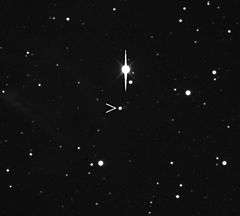624 Hektor
|
Star field showing Hektor (apmag 15) | |
| Discovery | |
|---|---|
| Discovered by | August Kopff |
| Discovery date | 10 February 1907 |
| Designations | |
| Pronunciation | /ˈhɛktɔːr/ HEK-tor |
Named after | Hector |
| 1907 XM; 1948 VD | |
| Jupiter trojan (leading cloud) | |
| Adjectives | Hektorian |
| Orbital characteristics[1] | |
| Epoch 22 October 2004 (JD 2453300.5) | |
| Aphelion | 5.349 AU (800.220 Gm) |
| Perihelion | 5.095 AU (762.145 Gm) |
| 5.222 AU (781.183 Gm) | |
| Eccentricity | 0.024 |
| 11.93 a (4358.521 d) | |
Average orbital speed | 13.03 km/s |
| 94.752° | |
| Inclination | 18.198° |
| 342.791° | |
| 183.579° | |
| Known satellites |
S/2006 (624) 1[2] (diameter of 15 km) |
| Physical characteristics | |
| Dimensions |
370 × 195 × 195 km[3] 226.68 ± 15.15 km[4] |
| Mass | (9.95 ± 0.12) × 1018 kg[4] |
Mean density |
1.0 ± 0.3 g/cm3 [5] 1.63 ± 0.32 g/cm3 [4] 2.43 ± 0.35 g/cm3[6] |
| ~ 0.067 m/s² | |
| ~ 0.13 km/s | |
| 0.2884 d (6.92 h)[7] | |
| Albedo | 0.025 (geometric)[1] |
| Temperature | ~ 122 K |
Spectral type | D |
| 13.79 to 15.26 | |
| 7.49[1] | |
| 0.078" to 0.048" | |
|
| |
624 Hektor is the largest Jupiter trojan. It was discovered in 1907 by August Kopff.
Hektor is a D-type asteroid, dark and reddish in colour. It lies in Jupiter's leading Lagrangian point, L4, called the 'Greek' node after one of the two sides in the legendary Trojan War. Hektor is named after the Trojan hero Hektor and is thus one of two trojan asteroids that is "misplaced" in the wrong camp (the other one being 617 Patroclus in the Trojan node).
Contact binary plus moon
Hektor is one of the most elongated bodies of its size in the Solar System, being 370 × 200 km. It is thought that Hektor might be a contact binary (two asteroids joined by gravitational attraction) like 216 Kleopatra. Hubble Space Telescope observations of Hektor in 1993 did not show an obvious bilobate shape because of a limited angular resolution. On 17 July 2006, the Keck 10-meter-II-telescope and its laser guide star adaptive optics (AO) system indicated a bilobate shape for Hektor.[8] Additionally, a 12-km-diameter moon of Hektor, S/2006 (624) 1, was detected orbiting with a semi-major axis of 623.5 km and an orbital period of 2.9651 day.[2][5] It was confirmed with Keck observations in November 2011.[9] Hektor is, so far, the only known binary trojan asteroid in the L4 point and the first known trojan with a satellite companion. 617 Patroclus, another large trojan asteroid located in the L5, is composed of two same-sized components.[8]
| Trojan | Diameter (km) |
|---|---|
| 624 Hektor | 225 |
| 911 Agamemnon | 167 |
| 1437 Diomedes | 164 |
| 1172 Äneas | 143 |
| 617 Patroclus | 141 |
| 588 Achilles | 135 |
| 1173 Anchises | 126 |
| 1143 Odysseus | 126 |
| Source: JPL Small-Body Database, IRAS data | |
Hektor in fiction
References
- 1 2 3 "JPL Small-Body Database Browser: 624 Hektor (1907 XM)" (5 September 2008 last obs). Retrieved 1 November 2008.
- 1 2 "IAUC 8732: S/2006 (624) 1 (Satellite Discovery)". Retrieved 23 July 2006.
- ↑ Storrs, Alex; Weiss, B.; Zellner, B. (1998). "Imaging Observations of Asteroids with Hubble Space Telescope" (PDF). Icarus. 137 (2): 260–268. Bibcode:1999Icar..137..260S. doi:10.1006/icar.1999.6047. Retrieved 22 May 2008.
- 1 2 3 Carry, B. (December 2012), "Density of asteroids", Planetary and Space Science, 73, pp. 98–118, arXiv:1203.4336
 , Bibcode:2012P&SS...73...98C, doi:10.1016/j.pss.2012.03.009. See Table 1.
, Bibcode:2012P&SS...73...98C, doi:10.1016/j.pss.2012.03.009. See Table 1. - 1 2 Marchis, Frank; Durech, Josef; Castillo-Rogez, Julie; Vachier, Frédéric; Ćuk, Matija; Berthier, Jérôme; Wong, Michael H.; Kalas, Paul; Duchene, Gaspard; van Dam, Marcos A.; Hamanowa, H.; Viikinkoski, M. (28 February 2014). "The Puzzling Mutual Orbit of the Binary Trojan Asteroid (624) Hektor". The Astrophysical Journal Letters. L37 (2014). arXiv:1402.7336
 . Bibcode:2014ApJ...783L..37M. doi:10.1088/2041-8205/783/2/L37.
. Bibcode:2014ApJ...783L..37M. doi:10.1088/2041-8205/783/2/L37. - ↑ Descamps, Pascal (2015). "Dumb-bell-shaped equilibrium figures for fiducial contact-binary asteroids and EKBOs". Icarus. 245: 64–79. arXiv:1410.7962
 . Bibcode:2015Icar..245...64D. doi:10.1016/j.icarus.2014.08.002. ISSN 0019-1035.
. Bibcode:2015Icar..245...64D. doi:10.1016/j.icarus.2014.08.002. ISSN 0019-1035. - ↑ Detal, A.; Hainaut, O.; Pospieszalska-Surdej, A.; Schils, P.; Schober, H. J.; Surdej, J. (1994). "Pole, albedo and shape of the minor planets 624 Hektor and 43 Ariadne". Astronomy and Astrophysics. 281: 269. Bibcode:1994A&A...281..269D. ISSN 0004-6361.
- 1 2 Franck Marchis. "Searching and Characterizing Multiple Trojan Asteroids with LGS AO Systems" (PDF).
- ↑ "Tiny moon of (624) Hektor observed with Keck-AO NGS".
External links
- Orbital simulation from JPL (Java) / Ephemeris
- Keck image of Hektor and moon (Marchis 2011-Nov-11)
- Distant Asteroid Revealed to be a Complex Mini Geological World (2014 February 27)
- 624 Hektor at the JPL Small-Body Database

